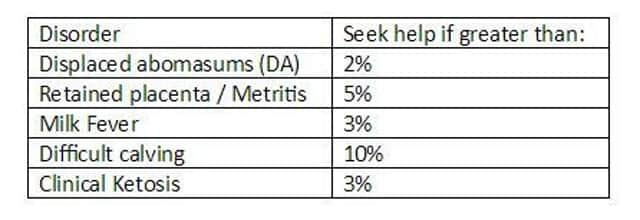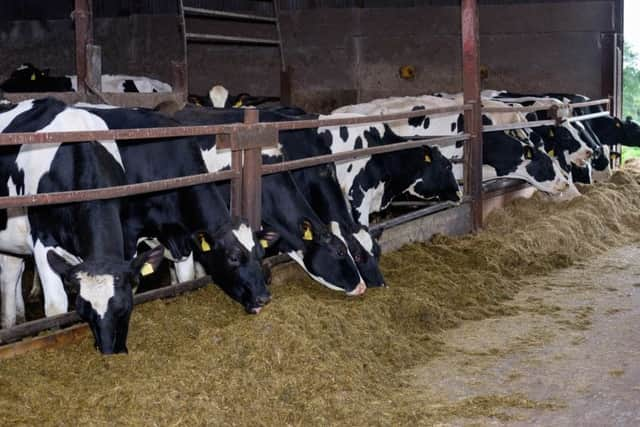How many cows leave the herd before 60 days in milk?


The transition period is traditionally termed as the last three weeks in the dry period prior to calving, and the first three weeks after calving. Many dairy herds today are looking to optimise transition cow management as they recognise this a critical period to get great returns in production, health and reproductive performance. We continue to learn that how our dry cows are fed, handled and managed can have a huge impact on their success in their next lactation.
Many of the metabolic disorders we see in herds can be related to transition management. During the three weeks in the run up to calving cows experience a multitude of changes including, reduced dry matter intakes, environmental and group changes and potentially ration changes also. Where this goes wrong, up to 10% of cows within herds can leave within the first 60 days of calving through culling and death – how many leave your herd before 60 days in milk?
Advertisement
Hide AdAdvertisement
Hide AdSuggested triggers for action when considering levels of metabolic disorders in your herd are highlighted in the table right – how does your herd perform?


Waiting to identify clinical disease as an indicator of transition cow performance can be frustratingly late – the proverbial milk has already been spilt in these cases! So we look to other ways of monitoring for when issues are arising which allow an intervention to reduce the risk of clinical disease. Monitors for transition cows might be through monitoring body condition changes over time or alternatively blood testing dry cows to monitor for excessive fat mobilisation pre-calving and “ketone testing” fresh cows with a handheld device cow-side your vet and nutritionist should be able to assist you with this. More latterly transition cow monitoring has moved to the use of “cow-wearable technology” to assess cow behaviour with the ability to monitor time at feed face, standing and lying times. As these systems develop their algorithms they aim to identify sick cows sooner to allow early intervention and prevent transition cow failures.
However optimising transition cow performance, rather than merely the ability to intervene on sick cows sooner, should be the aim of a transition cow management program. Identifying and negating bottlenecks in the transition management program on your farm is key to providing great transition cow success, requiring great stockmanship, good decision making and sound data to work from.
Consider the following questions for your farm and work with your farm team, vet, nutritionist and breed advisor to create positive solutions for your transition cows.
Advertisement
Hide AdAdvertisement
Hide Ad1. Do you control milk fever by managing macromineral / DCAD balance of dry cows ration especially in the last two-three weeks before calving? You may also consider calcium binding agents?
2. Do you get feeding management consistently right every day? For example, minimise sorting by getting chop length correct – in dry rations consider adding water as guided by your nutritionist.
3. Do you provide clean comfortable housing and fresh water? Do your dry cows have 75cm or more of feed space per cow (Holsteins) and 24 hours per day stress-free access to fresh palatable feed? Do your dry cows have constant availability of fresh, clean water with 10 linear cm water trough space per cow. Can your transition cow housed area be stocked to 85-90% at the feed face and can it cope with times of peak calvings? Is the resting area of the dry cow facility adequate? – minimum of 1m2 lying space per 1000 litres milk production (per cow per year) for loose housed precalvers, plus a third as much again loafing/feeding area. Cows housed in cubicles need large comfortable beds.
4. Do your cows spend the correct amount of time in the transition cow facility? Should you consider early pregnancy diagnosis to ensure correct dates for dry off? Do you move cows carrying twins to the transition pens earlier to allow for the risk of shorter gestation length?
Advertisement
Hide AdAdvertisement
Hide Ad5. Are your cows going into the dry period with a higher or lower body condition than you would like or are they gaining or losing weight through the dry period? This is common where reproductive performance in the last lactation has been poor. Consider strategic use of feed additives and specific nutrients such as monensin boluses etc to assist specifics cows or cohorts.
6. Do you have a cow and herd level monitoring program written down and actioned with your farm team? This should include what will be monitored, how often, by whom and crucially what level triggers and action and what is that action. This should include building a sound genetic plan, to ensure your future replacements are at less risk of transition related disorders.
In summary, reflecting with your farm team and advisors, on how you monitor processes and predict periods of risk for transition cows will allow you to make proactive actions to create transition cow success consistently, rather than report on disease outcomes that have already happened.